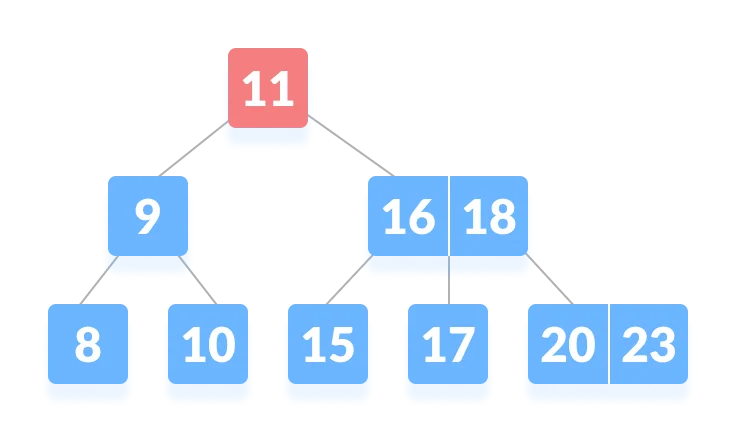Hi everyone, inside this article we will see the concept about B-Trees.
B-Tree is a data structure in computer science that is used to organize and store large amounts of data. It is a balanced tree-like structure that is optimized for storing and retrieving data in external storage devices such as hard drives and SSDs.
The B-Tree was first introduced by Rudolf Bayer and Edward McCreight in 1970 and has since become a fundamental data structure used in many database systems.
B-Trees are designed to handle large amounts of data and provide efficient operations for searching, insertion, and deletion. They achieve this by allowing nodes with multiple keys and child nodes, which reduces the depth of the tree and the number of disk accesses required to access a specific data item.

Properties of B-Trees
B-Trees have several properties that make them a useful data structure for storing and accessing large amounts of data. The main properties of B-Trees are:
- Balanced tree: B-Trees are balanced trees, which means that all leaf nodes are at the same depth. This allows for efficient searching, insertion, and deletion operations.
- Multiple keys per node: B-Trees allow for multiple keys to be stored in each node, which reduces the depth of the tree and the number of disk accesses required to access a specific data item.
- Variable node size: B-Trees have a variable node size, which means that the number of keys and child pointers in each node can vary based on the size of the data being stored.
- Ordered keys: B-Trees store their keys in a sorted order, which allows for efficient searching and traversal of the tree.
- Efficient disk access: B-Trees are optimized for accessing data on external storage devices such as hard drives and SSDs, which allows for efficient access to large amounts of data.
- Multiple levels: B-Trees can have multiple levels, which allows them to store and access large amounts of data efficiently.
- Self-balancing: B-Trees are self-balancing, which means that they automatically adjust their structure to maintain balance as data is inserted and deleted. This ensures that the tree remains efficient for all operations.
Types of Operation perform on B-Trees
B-Trees support a variety of operations for storing and retrieving data efficiently. The main operations that can be performed on B-Trees are:
- Search: Given a key, search the B-Tree for the node that contains the key.
- Insert: Insert a new key-value pair into the B-Tree.
- Delete: Remove a key-value pair from the B-Tree.
- Traversal: Traverse the B-Tree to visit all of the nodes and keys in a specific order.
- Range search: Find all keys within a specified range.
- Split: Split a node into two nodes when it becomes full.
- Merge: Merge two nodes into a single node when they become too empty.
- Rebalance: Rebalance the B-Tree by adjusting the structure to maintain balance.
- Update: Update the value associated with a key in the B-Tree.
These operations are designed to provide efficient access to large amounts of data, and they are optimized for use on external storage devices such as hard drives and SSDs. B-Trees are commonly used in databases and file systems, where they provide efficient storage and retrieval of data.
Algorithms for B-Trees Operations
Here is the Algorithms for the main operations on B-Trees:
Search:
- Start at the root node.
- Compare the search key with the keys in the node.
- If the key is found, return the corresponding record.
- If the key is not found, move to the child node that would contain the key.
- Repeat the process until the key is found or the leaf node is reached.
Insert:
- Search for the key to be inserted.
- If the key is already in the tree, update the corresponding record.
- If the leaf node where the key would be inserted has enough space, insert the key.
- If the leaf node is full, split it into two nodes and redistribute the keys.
- Update the parent node by inserting the key or the new node.
- If the parent node is full, split it and update its parent.
Delete:
- Search for the key to be deleted.
- If the key is not found, do nothing.
- If the key is in a leaf node and the node is at least half-full, delete the key.
- If the key is in a leaf node and the node is less than half-full, borrow a key from a sibling node or merge with a sibling node.
- If the key is in an internal node, replace the key with the largest key in the left subtree or the smallest key in the right subtree.
- If the child node where the key was found is less than half-full, borrow a key from a sibling node or merge with a sibling node.
- Update the parent node by deleting the key or the child node.
- If the parent node is less than half-full, borrow a key from a sibling node or merge with a sibling node.
Complexity Analysis of B-Trees
Here is the complexity analysis of B-trees:
| Operation | Worst-case time complexity |
|---|---|
| Search | O(log n) |
| Insertion | O(log n) |
| Deletion | O(log n) |
Note that the time complexity of each operation depends on the height of the B-tree, which in turn depends on the order of the tree (i.e., the value of t). The above time complexity analysis assumes a balanced B-tree with order t and n keys.
Where we use B-Trees?
B-trees are commonly used in database systems and file systems to store large amounts of data in a way that allows for efficient insertion, deletion, and retrieval operations. Here are some specific use cases for B-trees:
- File systems: B-trees are used to index and organize files on disk for quick access.
- Databases: B-trees are used to store indexes and data in relational databases and other data storage systems.
- Web servers: B-trees are used to store and manage web page access logs, allowing for quick searching and analysis of log data.
- Network routers: B-trees are used to store routing tables for efficient lookup and forwarding of network packets.
Overall, B-trees are a versatile data structure that can be used in a wide range of applications where efficient storage and retrieval of large amounts of data is required.
We hope this article helped you to understand B-Trees in a very detailed way.
Online Web Tutor invites you to try Skillshike! Learn CakePHP, Laravel, CodeIgniter, Node Js, MySQL, Authentication, RESTful Web Services, etc into a depth level. Master the Coding Skills to Become an Expert in PHP Web Development. So, Search your favourite course and enroll now.
If you liked this article, then please subscribe to our YouTube Channel for PHP & it’s framework, WordPress, Node Js video tutorials. You can also find us on Twitter and Facebook.
